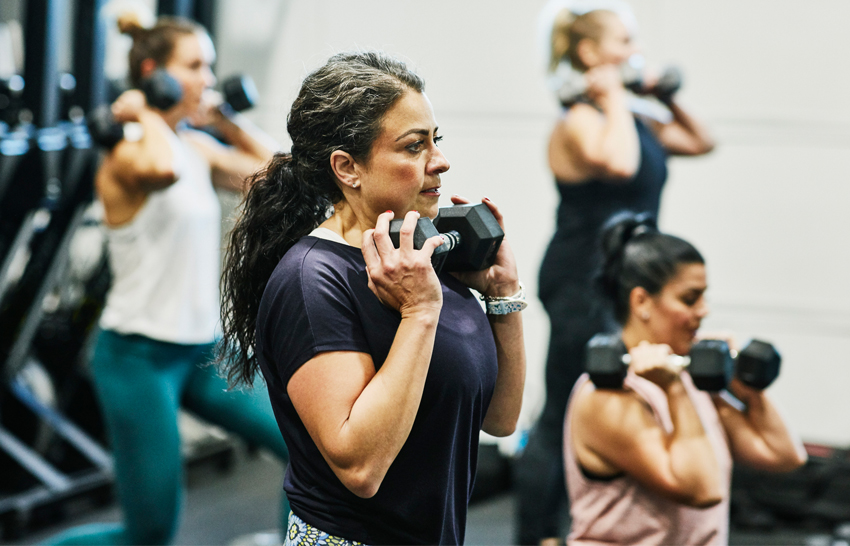

Imagine tripping on a rug in the living room. For a young woman, it’s a stumble. For a woman after menopause, it could mean a broken hip, months of recovery, or even a loss of independence. That is the stark reality of osteoporosis — the “silent thief” that weakens bones without warning.
Here is the sobering truth: women can lose up to 20% of their bone mass in just the first five to seven years after menopause.¹ One in three women over age 50 will suffer a fracture.² And a hip fracture? It carries up to a 20% chance of death within a year.² These are not just statistics. These are stories of mothers, sisters, and friends whose lives are changed in an instant.
But there is hope. And it does not come in a pill bottle.
The hidden power of strength
Strength training — lifting weights, using resistance bands, and even bodyweight exercises — is one of the most effective, evidence-backed ways to fight back against osteoporosis. Strong muscles tell your bones: rebuild, toughen up, and stay resilient.
Studies show that women who practice resistance training can slow bone loss, maintain muscle, and reduce falls.⁴ The goal isn’t necessarily bigger muscles. The goal is lasting strength that supports health and independence.
Why it matters
Every year after menopause, bone density drops 1–2%.³ Without intervention, that loss accumulates quickly. Falls affect 1 in 4 adults over 65 each year.² Weaker muscles increase the risk of injury during everyday activities. Strength training not only protects joints and balance to help prevent injuries, but also strengthens bones, supports healthy metabolism, improves posture, and boosts energy. Resistance training can even ease some menopause-related symptoms such as weight gain, fatigue, and mood swings. By building strength, it is possible to remain active, independent, and able to participate in daily activities.
Addressing bone health effectively also requires supportive policies. Medicare currently covers bone density testing for women 65 and older — but bone loss often begins years earlier.5 Many women remain undiagnosed until after a fracture. And while some Medicare Advantage plans cover gym memberships or fitness programs like SilverSneakers, access is not guaranteed.6 Strength training is powerful, but without consistent policy support, too many women are left without the tools to use it. Policymakers could consider expanding coverage for evidence-based exercise programs so that more women can access safe, supervised strength training.
Protecting bones before menopause is not just a personal responsibility — it is a public health opportunity.
What works
Frequency: 2–3 sessions a week.
Intensity: Use weights or bands that feel challenging but safe.
Duration: Stick with it — the real benefits show after 6–12 months.
Support: If you already have osteoporosis, start slow and get professional guidance.
The bottom line
Menopause does not have to mean fragile bones. Strength training is more than exercise — it is a lifeline. It gives women the power to write a different story: one where a stumble is just a stumble and not a fracture that changes everything.
Future strength is built today. Lifting weights strengthens bones and supports overall health. When policies enable earlier osteoporosis detection and equitable access to strength training, the benefits extend beyond individual women to families, communities, and the entire health system. Stronger women mean stronger community.
Author Bio:

Anjali Lobana, DO
Dr. Lobana is a Preventive Medicine resident at Loma Linda University who is passionate about lifestyle medicine, obesity medicine, and creation of healthier, more equitable communities. She believes in the power of prevention and is driven to make public health solutions both practical and inclusive. When she is not in the clinic or working on community projects, she enjoys connecting with others over food, movement, and meaningful conversations about health.
References
- National Institute on Aging. “Osteoporosis.” https://www.nia.nih.gov/health/osteoporosis/osteoporosis
- International Osteoporosis Foundation. “Facts and Statistics.” https://www.osteoporosis.foundation/facts-statistics
- Endocrine Society. “Menopause and Bone Health.” https://www.endocrine.org/menopausemap/health-impacts/index.html
- Watson SL; Weeks BK; Weis LJ; Harding AT; Horan SA; Beck BR. “High-Intensity Resistance and Impact Training Improves Bone Mineral Density and Physical Function in Postmenopausal Women With Osteopenia and Osteoporosis: The LIFTMOR Randomized Controlled Trial.” Journal of Bone and Mineral Research. 2018 Feb; 33(2):211-220. https://pubmed.ncbi.nlm.nih.gov/28975661/
- Medicare. “Bone Mass Measurements.” https://www.medicare.gov/coverage/bone-mass-measurements
- SilverSneakers. “Check Your Eligibility.” https://tools.silversneakers.com/Eligibility/HealthPlans
